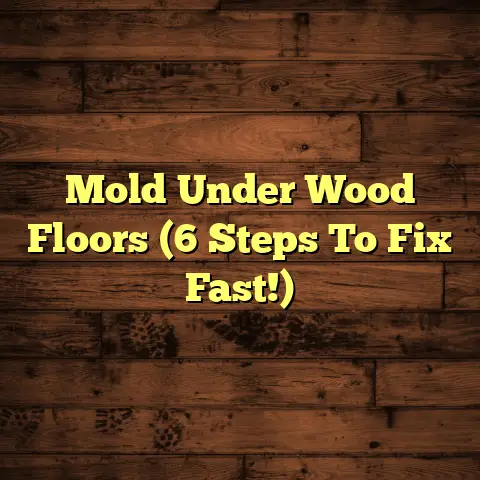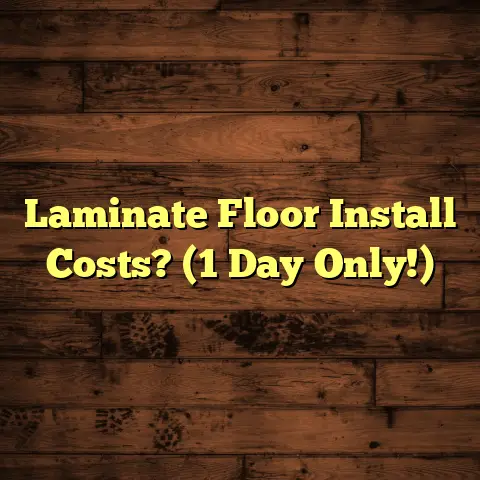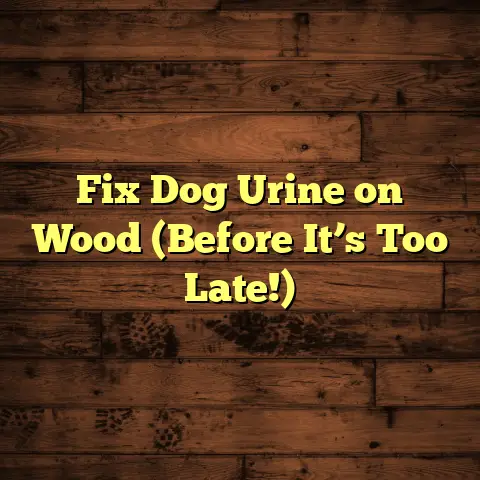Removing Glued Linoleum? (1 Trick Installers Use!)
Ever walked into your kitchen, stared at that faded, outdated linoleum floor, and felt a wave of… well, annoyance wash over you?
I get it. You remember all the family dinners, the spilled juice boxes, the dog’s muddy paw prints – all etched into that very surface.
The thought of ripping it all out seems like a Herculean task, right? A messy, back-breaking ordeal that you’d rather avoid. But that vision of a fresh, new floor keeps nagging at you.
Trust me, I’ve been there. As a flooring contractor for over 15 years, I’ve seen it all. And I’m here to tell you that removing glued linoleum doesn’t have to be a nightmare.
There’s a trick that us installers use that can make the job significantly easier. Ready to learn the secret? Let’s dive in!
Section 1: Understanding Glued Linoleum
So, what exactly is linoleum?
It’s a natural flooring material made from things like linseed oil, rosin, cork dust, wood flour, and pigments, pressed onto a jute backing.
Pretty eco-friendly, right?
Linoleum became super popular because it’s durable, relatively easy to maintain, and can come in a huge range of colors and patterns.
Think of those retro kitchens with the checkerboard floors – chances are, that was linoleum!
But, like all things, linoleum doesn’t last forever.
Why do homeowners decide to remove it?
-
Damage: Years of wear and tear can lead to tears, gouges, and stains that are impossible to get rid of.
-
Outdated Style: Let’s face it, some linoleum patterns just scream “1970s avocado green.” If you’re updating your home, that old flooring might need to go.
-
Desire for New Materials: Maybe you’re dreaming of hardwood, tile, or luxury vinyl plank. Whatever your vision, the old linoleum has to go first.
I have seen a lot of cases, where people prefer tile flooring over linoleum due to its superior water resistance.
According to the National Association of Realtors, homes with updated flooring often see a higher resale value. ^(National Association of Realtors)
Section 2: The Challenges of Removing Glued Linoleum
Okay, let’s be real.
Removing glued linoleum is rarely a walk in the park. The biggest challenge? That stubborn adhesive. Over time, that glue can become rock-hard, making it incredibly difficult to separate the linoleum from the subfloor.
Here are some other common issues:
-
Damage to the Subfloor: In the process of scraping and prying, you can easily gouge or crack the subfloor underneath. Repairing that can add extra time and expense to your project.
-
The Mess: Scraping up linoleum creates a lot of dust and debris. Prepare for a messy job and make sure you have a good vacuum cleaner.
-
Time Commitment: Depending on the size of your room and how well the linoleum is glued down, this project can take several hours, or even days.
I remember one client, Sarah, who tried to remove the linoleum in her bathroom herself.
She spent an entire weekend wrestling with it, only to end up with a sore back, a partially removed floor, and a whole lot of frustration.
“I thought I could handle it,” she told me later. “But that glue was like concrete! I ended up calling you guys anyway.”
Sarah’s story is a good reminder that sometimes it’s worth calling in the pros. But if you’re determined to DIY, keep reading!
Section 3: The Essential Tools and Materials
Alright, let’s gear up.
Having the right tools will make this job so much easier. Here’s what you’ll need:
-
Safety Gear: Safety glasses, gloves, and a dust mask are essential. You don’t want to get adhesive or debris in your eyes, or breathe in harmful dust.
-
Flooring Scraper: A good quality flooring scraper with a sharp blade is your best friend. Look for one with a long handle for better leverage. I personally prefer a 4-inch scraper with a replaceable blade.
-
Heat Gun: This is the “one trick” we’ll be talking about! A heat gun softens the adhesive, making it much easier to scrape up the linoleum. Make sure to use it carefully and follow safety precautions.
-
Adhesive Remover: Even with heat, some adhesive will likely remain. A good adhesive remover will help you get rid of those stubborn patches. Look for one that’s specifically designed for flooring adhesive.
-
Putty Knife: A smaller putty knife can be helpful for getting into corners and tight spots.
-
Trash Bags/Buckets: You’ll need something to collect all the old linoleum and adhesive.
-
Shop Vacuum: A shop vacuum is essential for cleaning up the dust and debris.
-
Scraper Blades: Blades will dull quickly, so make sure to have extras on hand.
Where to source these tools?
Your local hardware store (like Home Depot or Lowe’s) will have most of what you need.
You can also find tools online on Amazon or specialty flooring supply websites.
Pro Tip: Don’t skimp on quality! Investing in good tools will make the job easier and prevent you from having to replace them halfway through.
Section 4: The Step-by-Step Process
Okay, here’s the breakdown.
Follow these steps carefully, and you’ll be well on your way to a linoleum-free floor!
Step 1: Preparing the Workspace
-
Clear the Room: Remove all furniture, rugs, and anything else that might get in the way.
-
Protect Adjacent Surfaces: Cover any walls, cabinets, or trim with painter’s tape and plastic sheeting to protect them from damage.
-
Ventilate the Area: Open windows and doors to provide good ventilation, especially when using adhesive remover.
Step 2: Assessing the Linoleum
-
Identify the Adhesive: Try to determine what type of adhesive was used. This can help you choose the right adhesive remover later on. Old linoleum is likely to have been installed with solvent-based adhesive.
-
Check for Asbestos: If your home was built before the 1980s, there’s a chance the linoleum or adhesive contains asbestos. Do not attempt to remove it yourself! Contact a professional asbestos abatement company. According to EPA, Asbestos exposure can cause cancer and other health problems.
Step 3: The “One Trick” Installers Use: Heat
-
The Magic of Heat: Here’s the secret weapon! A heat gun softens the adhesive, making it much easier to scrape up the linoleum.
-
How to Use It: Hold the heat gun a few inches above the linoleum, moving it back and forth in a sweeping motion. Don’t hold it in one spot for too long, or you could scorch the linoleum or even the subfloor.
-
Safety First! Heat guns get very hot. Wear gloves and be careful not to touch the nozzle. Also, be mindful of flammable materials nearby.
-
Why It Works: Heat loosens the bond between the adhesive and the linoleum, making it more flexible and easier to peel up.
I have seen a lot of cases where the trick of using heat gun helps to remove the linoleum easily without damaging the subfloor.
Step 4: Removing the Linoleum
-
Start at a Corner: Use a putty knife to loosen a corner of the linoleum.
-
Heat and Scrape: Apply heat to the area directly in front of the corner, then use your flooring scraper to peel up the linoleum. Work slowly and methodically, applying heat as needed.
-
Work in Sections: Don’t try to remove the entire floor at once. Work in small sections, heating and scraping as you go.
-
Be Patient: Some areas will be more difficult than others. Don’t get discouraged! Just keep applying heat and scraping.
Step 5: Cleaning Up
-
Remove Adhesive Residue: Once the linoleum is gone, you’ll likely have some adhesive residue left behind. Apply adhesive remover according to the manufacturer’s instructions. Let it sit for the recommended time, then scrape it away with your flooring scraper or putty knife.
-
Clean the Subfloor: Vacuum the subfloor thoroughly to remove any remaining dust and debris.
-
Inspect for Damage: Check the subfloor for any damage, such as gouges, cracks, or unevenness. Repair any damage before installing your new flooring.
Section 5: Real-Life Examples and Success Stories
I remember another client, Mark, who was dreading removing the linoleum in his entryway.
He’d seen some online videos and was convinced it was going to be a nightmare.
But after I showed him the heat gun trick, he was amazed at how much easier it was.
“I couldn’t believe it,” he told me. “The linoleum just peeled right up! I finished the whole job in a few hours.”
Mark installed new tile in his entryway, and it completely transformed the space.
“It looks so much more modern and inviting,” he said. “I’m so glad I finally got rid of that old linoleum.”
I have another client, Jessica, who shared photos of her kitchen renovation on Instagram.
She’d removed the old linoleum herself using the heat gun trick, and the before-and-after photos were stunning.
Her followers were so impressed, and many of them commented that they were inspired to tackle their own flooring projects.
These stories are a testament to the power of knowledge and the satisfaction of DIY projects.
Section 6: The Importance of Patience and Persistence
Look, I’m not going to lie.
Removing glued linoleum can be challenging.
There will be times when you feel like giving up, when the adhesive just won’t budge, or when you’re covered in dust and sweat.
But don’t lose heart! Remember why you started this project in the first place.
You’re transforming your space, creating a home that you love, and expressing your personal style.
Embrace the challenges, learn from your mistakes, and celebrate your successes along the way.
And when you finally step back and admire your newly floored room, you’ll feel a sense of accomplishment that’s hard to beat.
According to a study by the University of Texas, people who engage in DIY projects report higher levels of happiness and well-being. ^(University of Texas)
Conclusion
So, there you have it!
The “one trick” installers use to remove glued linoleum: heat. It’s a simple but effective technique that can save you time, effort, and a whole lot of frustration.
Now, close your eyes for a moment and imagine your newly enhanced space, free from the constraints of that old linoleum.
Picture the possibilities: gleaming hardwood, stylish tile, or cozy carpet.
It’s all within your reach.
The journey of removing glued linoleum is not just about the physical act, but also about reclaiming your home and expressing your personal style. It’s about creating a space that reflects who you are and how you want to live.
So, take a deep breath, gather your tools, and take that first step.
Armed with the knowledge of the trick installers use, you can turn a daunting task into a rewarding endeavor.
I know you can do it!



![[Rewriting this as it’s outside the flooring context]](https://engineerhardwoodflooring.com/wp-content/uploads/2025/02/Rewriting-this-as-its-outside-the-flooring-context.png)

